Economic activity of the population - 3rd quarter of 2011
Employment
Within the European Union the Czech Republic belongs to countries with a slightly above average employment rate. According to the latest data for Q2 2011 the employment rate of the aged 15-64 years for the total of 27 Member States attained 64.5% and in the Czech Republic it was by 1.2 percentage points (p.p.) higher in the same period. The female employment rate, however, was in the Czech Republic lower than the Union average (57.1% in the CR, 58.7% in the EU27). On the contrary, the male employment rate was significantly higher than that of the total of all Member States (74.1%, i.e. by 3.8 p.p. more than in the EU27).
Compared to the same period of the previous year employment in the Czech Republic has grown higher than in the EU27, yet it has so far not reached the level attained three years ago. Employment of both males and females has increased more than in the whole EU. In Q2 of this year the employment rate in the wide group of productive age persons in the Czech Republic was the ninth highest within the EU27.
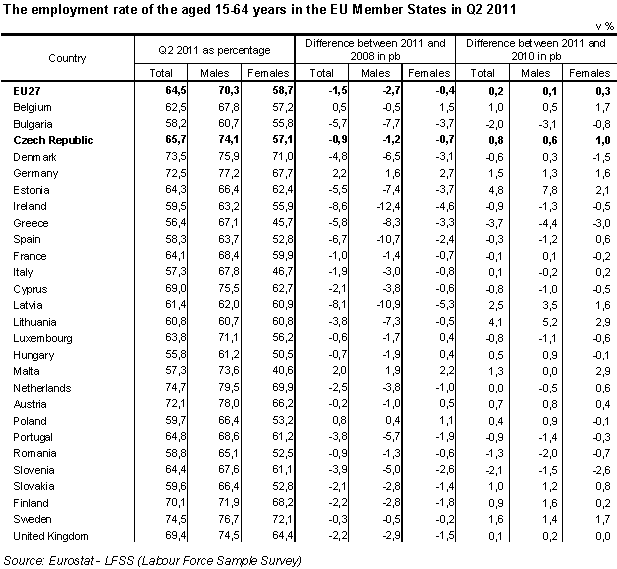
Great differences between respective EU countries in the employment level has still been persisting not solely concerning the whole group aged 15-64 years, yet both in the male and female components of the population. On one hand, employment has still been reaching high values in Nordic countries, Netherlands, Germany, and Austria, on the other hand, in ten countries employment has not been reaching even 60% of the population of a given age group. The employment level is low especially in countries with economic troubles, which are often cited in media as Greece, Italy, Ireland, Spain, but also in numerous countries of Central and Eastern Europe as Bulgaria, Hungary, Poland, Romania, and Slovakia. The value of the employment rate is highly variable; its span runs from 55.8% in Hungary up to 74.7% in the Netherlands. Compared to the previous year employment increased in majority of the Member States yet the total annual increment was mere 0.2 p.p. In some countries employment has been further falling namely in Greece, Ireland, Portugal, Slovenia, Bulgaria, and Romania. When compared to our country neighbours, Germany and Austria have had higher employment rates over a long term yet those in Poland and Slovakia are significantly lower.
The employment rate developed in opposite trends in respective age groups. The following table gives specific employment rates in certain selected countries. Because of the different age limit for retirement the data on the age group of 55-64 years are given separately for males and females.
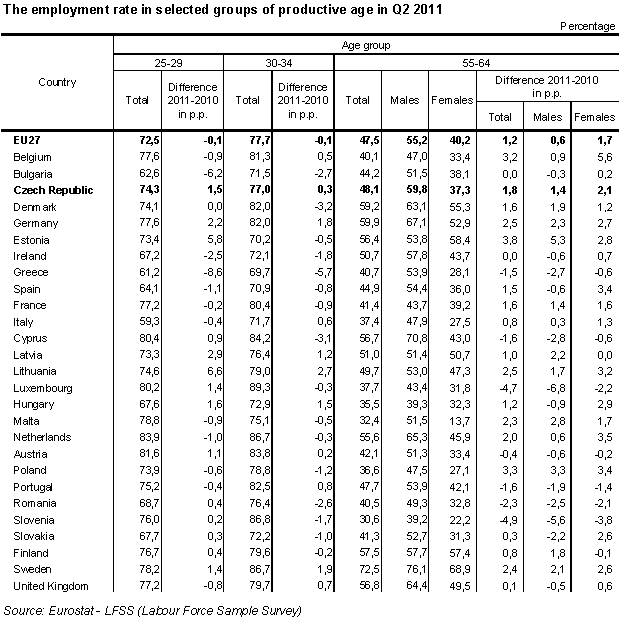
The employment rate was beneficially affected by the development in the oldest ten-year age group of the productive age of 55-64 years. The employment rate of these persons has been steadily growing and is higher not solely compared to data acquired one year ago but exceeds also the level of 2008. Compared to 2010 the employment level of the aged 55-64 years has increased in eighteen countries. This is a result of an increased age limit for termination of economic activities, both for the reason the age required for the creation of entitlement to retire and the prolongation of the persons’ own economic activities as a decisive condition to maintain one’s standard of living. Employment in females of this age group has been growing faster than that of males.
The development in the employment rate of younger persons of the productive age has been completely different. The development of the rate in the group of young males and females up to 25 years is not taken into account because a great portion of them has been under preparation in educational institutions for their future occupations. In the group of aged 25-29 years, however, there is a noticeable decline in the employment rate, especially against the year 2008, yet this rate has dropped slightly even if compared to Q2 2010, on the contrary to the group aged 55-64 years. What is quite exceptional is the fall in the employment rate of the young aged 25-29 years in Greece (by 8.6 p.p.!), but also that in Bulgaria. The increase in the employment rate in all of the three Baltic States is remarkable and is bound to compensation of the very unfavourable development in previous years.
Employment decreased year-on-year in majority of countries in the age group of 30-34 years and in no country it has reached the level thereof in 2008. In this age group there is a substantial drop in employment again in Greece and Bulgaria where employment has already been deep below the EU27 average.
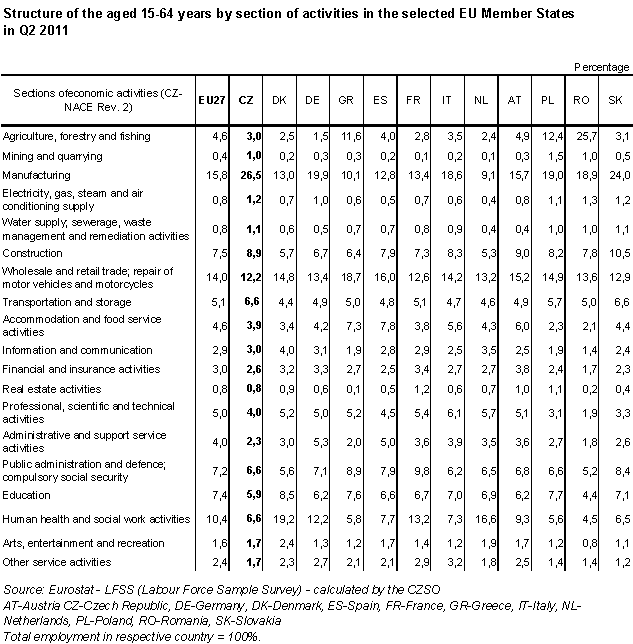
A high share of employment in the secondary sector (industry and construction) is characteristic for the Czech Republic economy. This share was the highest one of all the EU countries. The share of working persons in this manufacturing sector of Slovakia is the only one close to that in the CR, which indicates similar economic ties to foreign countries. In the Czech Republic the share of working persons in manufacturing is the absolutely highest (26.5%) in the EU, that in construction is the fifth highest, and the share of working persons in mining and quarrying is also among the highest in Europe.
When the manufacturing sector share in the total employment is high conditions in numerous activity sections of the tertiary sector appear markedly different. The share of working persons in transportation and storage in the Czech Republic is higher than average. In this context the highest shares of such working persons are in the Baltic States and in Hungary. In all other sections of services, however, the share of working persons in the Czech Republic is lower than in the EU27 (the only exception is information and communication activities yet for which the difference is minimum and is around the limit of the sampling error).
In the Czech Republic there are significantly less persons working mainly in education and, especially, in health and social cares. Differences among countries can be demonstrated in the relation of employment in manufacturing and the number of working persons in human health and social work activities. The share of working persons in manufacturing in the Czech Republic is four times higher than the share working persons in human health and social work activities. On the other hand, in all Nordic countries, Netherlands, and in the UK the number of working person in these activities substantially outnumbers the level of employment in manufacturing. In the Netherlands, for instance, there are 1.8 times more persons working in human health and social work activities than in manufacturing. And none of the aforementioned countries may be considered less industrialised.
The whole Europe, the Czech Republic being no exception, has been ageing. It is therefore clear that demands for human health and social work activities for older generations and especially for the eldest have been essentially rising. Thus this type of activities represents, along with childcare, an important factor affecting the social climate.
The employment structure by activity in the European Union is very varied and there are also great differences in the structure of working persons depending on their position in employment. The share of working persons in the position of employees in the Czech Republic is the fifth lowest of all the EU Member States. Greece, Italy, Poland, and namely Romania, where it accounts for mere 70% of the total employment, feature even lower share of employees. In Romania, moreover, there is an abnormally high number of family workers in agriculture.
The share of employees is mirrored in the share of the self-employed (with and without employees). In the EU27 the share of all self-employed, or the self-employed without employees, respectively occupies the fifth place. Compared to our neighbouring countries the Czech Republic has very similar structure of working persons with Slovakia again, although the share of the self-employed in the Czech Republic is higher. In Poland there are relatively more self-employed persons, yet the important factor in this case is a high number of individuals self-employed in agriculture. In Germany and Austria it is different and especially in Germany the share of the self-employed in the total employment is substantially lower than that in the Czech Republic. The share of own account workers, that means the self-employed without employees, in Germany is even 2.3 times lower than that in the Czech Republic. In general, it holds that the lowest share of the self-employed is in countries of the European North, in Germany, and, moreover, in Luxembourg.
In the Czech Republic there is a high share of self-employed persons mostly in construction, yet also in numerous activity sections of services. As it has been already mentioned, the Czech Republic economy features a lower share of employment in the tertiary sector but the share of the self-employed in this sector is substantial. Compared to the EU27, the Czech Republic has above average shares of the self-employed in trade (22.0% compared to 17.5% in the EU27), extremely high share of the self-employed is in workers in information and communication activities (24.3% compared to 15.2% in the EU27), and the highest share of the self-employed in the Czech Republic is the section of financial and insurance activities (26.2% compared to 8.9% in the EU), and the share of real estate activities is also high (35.4% in the CR and 21.5% in the EU). Almost a half of all working persons in professional, scientific, and technical activities 1 is the self-employed (45.0% in the CR, the EU average is 31.6%).
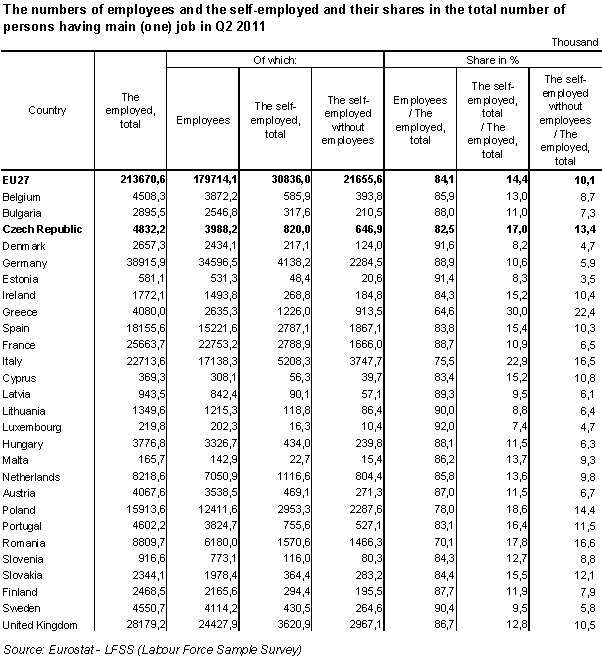
The Czech Republic belongs to countries with extraordinary high share of employees working full time. In Q2 2011 there were 4.7% of all persons with main (one) job working part time, that means the third lowest share of such person in the whole EU following to Bulgaria and Slovakia. The employment rates in Bulgaria and in Slovakia are, however, below average. The share of males working part time in the CR was the absolutely lowest one, and the share of females reached the third lowest value in the EU.
Especially in women the high differentiation of the share of part-time working hours is manifested in the total employment. In many countries of the original fifteen Member States a high number of women use the option to work part time, namely in the Netherlands (over three quarters of working females aged 15-64 years). In further four countries the share of part-time workers exceeded 40% of the total number of working women.
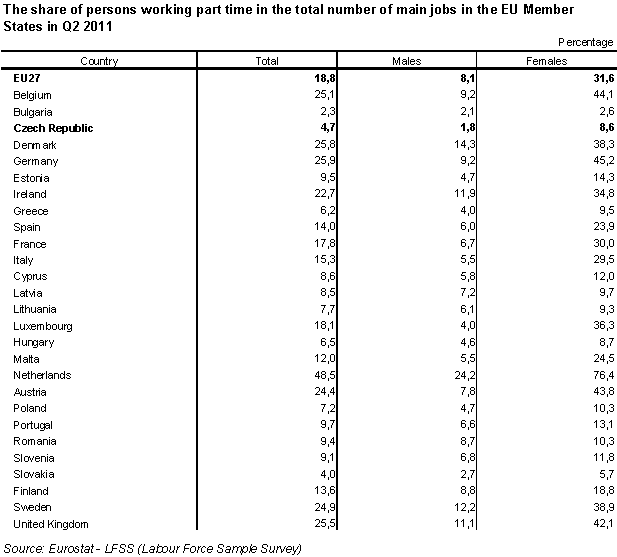
The option to work part time is one of the aspects, which are beneficial in reconciliation of family and career life and, last but not least, it is used for the prolongation of the career life in women in certain countries. Part-time jobs are often performed by persons who have attained the age limit for the old-age retirement or are at the age around sixty, respectively.
The sample survey investigates if working persons in the position of employees perform their activities for indefinite or definite period of time. Differences within the EU in the share of employees with employment contract for definite period of time (temporary employees) are significant. This share falls within the interval of almost 2% in Romania up to over one fourth of employees in Spain and Poland. The share of employees with this type of employment contract reached the tenth lowest value in the Czech Republic, while it has even dropped year-on-year.
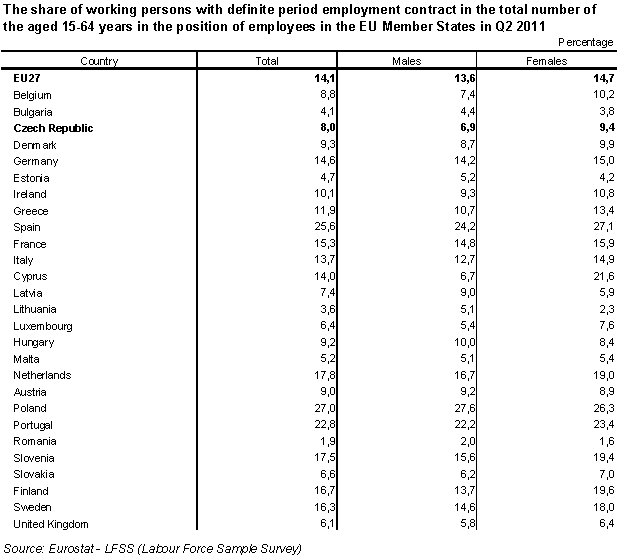
Unemployment
The general unemployment rate in the Czech Republic in Q2 2011 was among the lowest in the whole European Union. The share of the unemployed to the labour force, that means to the sum of the employed and the unemployed attained 6.8%, which is the sixth lowest value thereof in the EU27. Unemployment in males reached 5.9% (the fourth lowest); unemployment in females was 8.0% (the twelfth lowest value thereof). The Czech Republic position was favourably affected by the fact that unemployment dropped more year-on-year than on average of the EU Member States. Compared to 2010 unemployment was reduced most in the Baltic States, where it has been still at high values. A low unemployment rate was in the Netherlands and the absolutely lowest was in our southward neighbouring country of Austria. Its value was lower than that in our country also in Germany, but in Slovakia as well as in Poland it was substantially higher.
Ireland and, especially, Greece where unemployment grew year-on-year by 4.6 p.p have serious troubles. There is a critical situation in Spain where the unemployment rate has already attained 21%. Thus every tenth inhabitant aged 15-64 years is unemployed in this country.
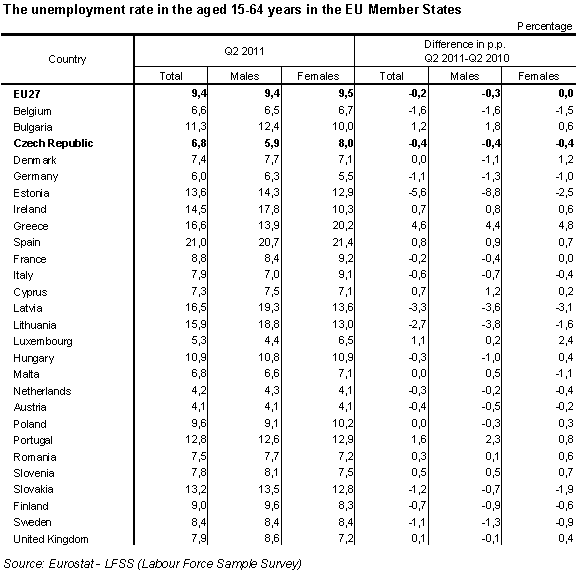
Troublesome economic and social conditions in numerous European countries are documented by the development in the long-term unemployment (the ratio of the over-one-year unemployed to the total number of the unemployed). The Czech Republic belongs to a few countries where the ratio of the long-term unemployment fell year-on-year. The ratio in the Czech Republic reached in Q2 of this year 39.1%, that is by almost 4 p.p. less than the EU average.
Essential changes occurred in many countries yet their economic conditions differ markedly. The share of the long-term unemployed has grown in the Netherlands and Denmark where the unemployment rate as well as the current share of the long-term unemployed are, however, relatively good. The share of the long-term unemployed has grown in numerous countries in the European South as Bulgaria, Greece, Spain, and Italy. The unemployment rate and simultaneously the share of the unemployed for over one year significantly increased, first of all, in Ireland. The development in the three Baltic States of Lithuania, Latvia, and Estonia is serious. The general unemployment rate in these countries fell year-on-year yet at the same time a substantial portion of the unemployed for a shorter period got transformed into those of the long-term unemployed.
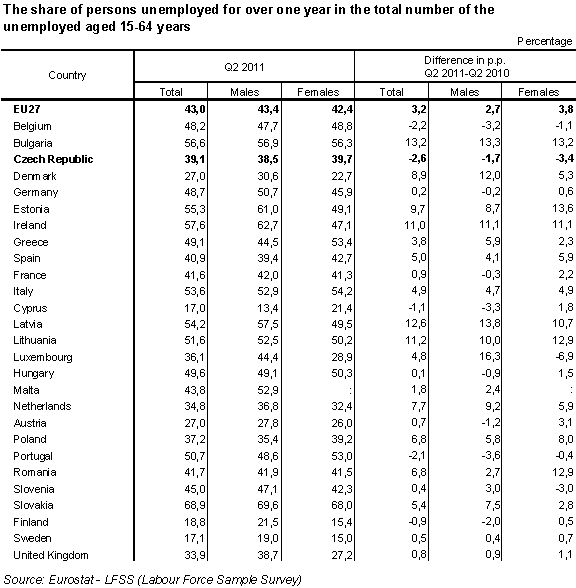
__________________
1 Methodological note: The section of professional, scientific and technical activities is very varied. In the Czech Republic it includes mostly workers in legal and accounting activities, architectural and engineering activities, advertising and market research, and scientific research and development.
- year 2017 | 4th quarter of 2017 | 3rd quarter of 2017 | 2nd quarter of 2017 | 1st quarter of 2017
- year 2016 | 4. quarter of 2016 | 3. quarter of 2016 | 2. quarter of 2016 | 1. quarter of 2016
- year 2015 | 4. quarter of 2015 | 3. quarter of 2015 | 2. quarter of 2015 | 1. quarter of 2015
- year 2014 | 4 quarter 2014 | 3 quarter 2014 | 2 quarter 2014 | 1 quarter 2014
- year 2013 | 4th quarter of 2013 | 3rd quarter of 2013 | 2nd quarter of 2013 | 1st quarter of 2013
- year 2012 | 4th quarter of 2012 | 3rd quarter of 2012 | 2nd quarter of 2012 | 1st quarter of 2012
- year 2011 | 4th quarter of 2011 | 3rd quarter of 2011 | 2nd quarter of 2011 | 1st quarter of 2011
Published: 04.11.2011
The data are valid as of the release date of the publication.
Contact: Information Services Unit - Headquarters, tel.: +420 274 056 789, email: infoservis@czso.cz










